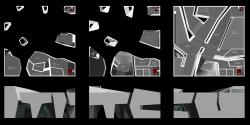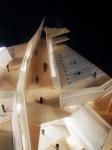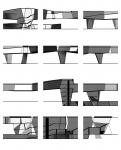The Museum of Music is situated on the seafront of the city of Thessaloniki at the east end of a long walkway that defines the edge of the city to the water.
The starting point of the design is a cube with the maximum allowed dimensions which in turn is ‘eroded’ and reduced to half of its volume in order to accommodate the necessary program of the museum. The ‘erosion’ of the volume results in a vertical artificial landscape that reflects the ubiquitous rocky coasts in Greece that erode from the salty wind of the sea.
The erosion-like sculpturing of the volume gave the opportunity of defining three different spaces of the museum in terms of programmatic specificity and space qualities. Starting from ground level the entrance of the museum faces a cave-like covered plaza where the angled shafts frame the view to the sea. This large embracing gesture of the building gives the effect of a melting together of the museum and the seafront platform and is serving as an entrance simultaneously for the museum, the restaurant and the cafeteria as well as a place for walking, leisure and music events.
The upper level houses the permanent and temporary exhibition spaces, the auditorium and the administration offices. The ‘erosion’ at this level results in short but intense view breaks in an otherwise indirectly illuminated space from the long narrow cuts on the volume. These cuts enable at parts visual connections with the activities going on underneath in the covered plaza.
Further up the museum space culminates in an open terrace with a panoramic view of the sea which can be accessed from three different places of the lower level and can function as an extension of the exhibition space.
2005
Favorited 2 times
.jpg)






